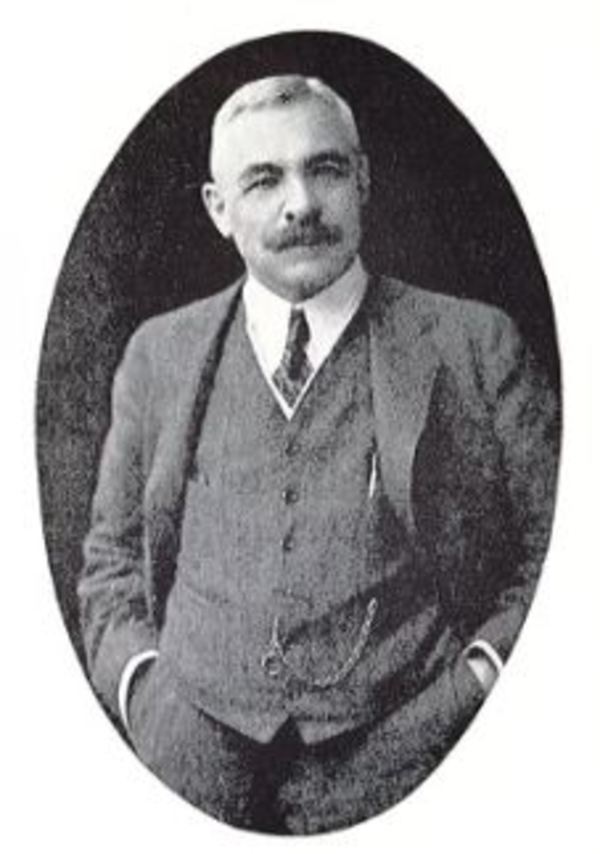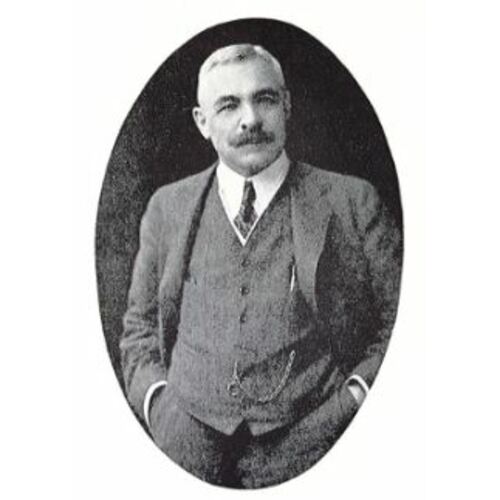
Source: Link
NORTHWAY, JOHN, tailor, merchant, clothing manufacturer, and philanthropist; b. 17 Aug. 1848 at Leat Farm, near Lifton, England, son of Thomas Neathern Northway and Grace Doidge; m. 1 June 1871 Catherine McKay in Embro, Ont., and they had eight children; d. 6 Nov. 1926 in Toronto.
John Northway’s father was a poor farmer in Devon; his mother’s once prosperous father had fallen into alcoholism and tenancy. John was looked to as the instrument of the family’s rehabilitation. A wilful and mischievous boy, he was removed from school at nine and apprenticed to a tailor for nine years, attempting once to cut off his thumb to escape his lot. In search of work in London, he became interested in ladies’ tailoring, design, and merchandising. Faced with another long apprenticeship, however, he fled to New York in 1869.
After being robbed and paid for some piecework in worthless Confederate money, he moved in 1870 to Hamilton, Ont., but it, and then Toronto and London, proved little better than New York. Discouraged, he took an assistantship to a tailor in the village of Embro, near Woodstock. The other assistant was Scottish-born Kitty McKay; spirited, intelligent in her trade, and canny in finance, she would play a major role in Northway’s success following their marriage. Embro was well positioned for Northway to root himself in Ontario’s southwest: his understanding that Cleveland (on the opposite shore of Lake Erie) had eclipsed Toronto in determining the region’s fashions gave him an edge.
On a joint salary of $12 weekly, Kitty saved $100, and in April 1873 the Northways opened a tailoring shop in Tilsonburg (Tillsonburg), one of the southwest’s most enterprising towns. A Baptist, “Brother John” attached himself to its leaders, especially the dominant Baptists and Liberals. His growing custom led him to add dry goods, and he absorbed the stocks of merchants hit by the depression of the 1870s. His credit rating rose. In 1886 he hired an assistant, Robert Marshall Anderson, who became his partner three years later when he bought a failing store in Orillia and left “R.M.” in charge at Tilsonburg. Northway’s career centred on taking over ailing firms and turning them around; eventually he held stores at Tilsonburg, Orillia, Simcoe, Ingersoll, St Thomas, Ridgetown, Woodville, Toronto, Chatham, Brantford, Hamilton, and Stratford. He inspected them routinely, shifted his managers to enliven the retailing, convened regular consultations, fixed standards of staffing, purchasing, and merchandising, and skirted brokerage houses by buying in bulk in Europe and the United States, where he also sketched the latest fashions.
In 1893 Northway moved to Toronto in the hope of forming his own brokerage, the Merchant’s Import Company. The move was premature, but when good times returned in 1895-96, he displaced the city’s only maker of ladies’ garments, Alexander and Anderson Limited; in 1898 he built a factory on Wellington Street, John Northway and Son Limited. There he designed and produced Northway mantles, coats, and (beginning in 1908) dresses and skirts, which he sold throughout Canada. He drew in his retail managers by granting them shares in the centralized firm chartered in 1900, the Northway Company Limited. In annual trips to the textile centre of Bradford, he observed the production methods and liberal employee policies of Sir Titus Salt and E. H. Gates and Company, two of Britain’s most respected garment manufacturers. Northway’s continued to grow. In 1903, on the urging of his partner-managers, he opened a retail outlet at 240-42 Yonge Street in Toronto. Although profits fell during a downturn in 1906-8, the store soon became a flourishing flagship. Because Northway specialized in womenswear, he did not consider himself to be in broad competition with the Eaton’s and Simpson’s department stores, but his strategy was plain: he countered Eaton’s claim of “Big bargains developed by big business” with the “exclusive” quality of Northway’s workmanship and fashions and the slogan “Style is a constant study in our designing rooms.” By 1911 he was beginning to exhibit a preference for fresh American styling.
Northway’s rise led to his appointment to the northern Ontario, wholesale dry goods, and waterfront development committees of the Toronto Board of Trade. The influence of its president, his friend, stockbroker Alfred Ernest Ames*, was also a factor. Northway was named a director of the powerful Imperial Bank of Canada in 1915, and became a member of the Canadian Manufacturers’ Association. As is evidenced by trips to Florida, club memberships, and the purchase of a Cadillac and a house in the exclusive Rosedale neighbourhood, he had moved into a different world, and he ruefully recognized it.
With his businesses in good condition by 1910 – two of his sons would become presidents, John Alexander of Northway and Son in 1913 and Arthur Garfield of the Northway Company in 1918 – Northway pursued the education he had been denied as a child. Ill at ease in large gatherings, he recorded that he possessed “knowledge far too limited to appreciate.” He began to read widely, religious studies at first and, later, works on the ancient world. In 1912 he and Kitty toured the Mediterranean and the Middle East; Egypt in particular caught his imagination. He made large contributions and endowed scholarships at McMaster, the Baptist university in Toronto, and at Brandon College in Manitoba, where he was counselled by President Howard Primrose Whidden*, a graduate of the liberal Chicago Theological Seminary and later chancellor of McMaster. In 1904 Mary Isabel Northway had married the Reverend Robert James Wilson, whose ministry and socially conscious training at the University of Chicago reinforced his father-in-law’s growing theological and social liberalism. During a lengthy recuperation in 1920 from prostate surgery, Northway audited college courses in Florida and California on literature and history, including one on liberalism, socialism, and communism. He was ecstatic when the Tutankhamen finds in Egypt were announced in 1922. Northway had been intellectually and socially awakened.
These new interests led to his rupture with the fundamentalist preaching of Thomas Todhunter Shields* at Jarvis Street Baptist Church. In 1921 he joined the progressive Walmer Road Baptist, the pulpit of John MacNeill. Under the guidance of Whidden, MacNeill, and McMaster’s Jones Hughes Farmer, another advocate of the Social Gospel and higher criticism of the Bible, Northway developed greater insight into his responsibilities as an employer. He had always been a benevolent figure, known to all as the Governor; now he added a deeper sense of stewardship. In his last years, despite the increasing pain of his cancer, he devoted himself to the charities of the day, but he paid special heed to his employees and McMaster’s students and faculty and took innovative steps for their care. In 1913 he set up a “Special Wages Fund” for ailing and distressed workers in his factory. Four years later an “Employee Benefit Trust Fund” was established for the stores. In 1919, after reviewing the pension schemes of Sir Titus Salt and others, he introduced his own non-contributory plan. (Eaton’s would not adopt a plan until 1949.) Northway died in 1926 and was interred in a mausoleum in Mount Pleasant Cemetery; he was survived by his wife, two daughters, and sons Jack and Garfield. From an estate valued at more than $1,816,000, he left a bequest to McMaster for needy theological students and challenged it with a $10,000 gift to initiate a pension plan, which it did.
From an intensive career spent building his own companies, Northway had grown to appreciate a broader world. Recognizing the problems of social reconstruction that followed the downturn of 1906-8 and World War I, he advanced a systematic approach to employee welfare and played no mean part in furthering industrial and business reform in labour matters.
A fuller treatment of John Northway is available in the author’s book John Northway, a blue serge Canadian (Toronto, 1965). The Northway papers are in the Trent Univ. Arch. (Peterborough, Ont.), 70-003, and a few papers are in the possession of the author.
AO, RG 22-305, no.55736; RG 80-5-0-25, 24: 456.
Cite This Article
ALAN WILSON, “NORTHWAY, JOHN,” in Dictionary of Canadian Biography, vol. 15, University of Toronto/Université Laval, 2003–, accessed January 1, 2026, https://www.biographi.ca/en/bio/northway_john_15E.html.
The citation above shows the format for footnotes and endnotes according to the Chicago manual of style (16th edition). Information to be used in other citation formats:
| Permalink: | https://www.biographi.ca/en/bio/northway_john_15E.html |
| Author of Article: | ALAN WILSON |
| Title of Article: | NORTHWAY, JOHN |
| Publication Name: | Dictionary of Canadian Biography, vol. 15 |
| Publisher: | University of Toronto/Université Laval |
| Year of publication: | 2005 |
| Year of revision: | 2005 |
| Access Date: | January 1, 2026 |



